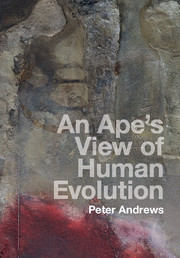Book contents
- Frontmatter
- Contents
- Preface
- 1 How can we recognize common ancestors?
- Part I Apes: their morphology and behaviour
- 2 Morphology and behaviour of living apes
- 3 Human and ape phylogenies
- 4 Review of fossil apes
- PART II Environments and palaeoenvironments
- Part III Review of fossil apes
- Part IV Last common ancestor
- References and further reading
- Index
- References
4 - Review of fossil apes
from Part I - Apes: their morphology and behaviour
Published online by Cambridge University Press: 05 January 2016
- Frontmatter
- Contents
- Preface
- 1 How can we recognize common ancestors?
- Part I Apes: their morphology and behaviour
- 2 Morphology and behaviour of living apes
- 3 Human and ape phylogenies
- 4 Review of fossil apes
- PART II Environments and palaeoenvironments
- Part III Review of fossil apes
- Part IV Last common ancestor
- References and further reading
- Index
- References
Summary
Fossil apes are known from over 20 million years ago up to very recently. The discovery of the first fossil ape, Dryopithecus fontani found in France in 1854, predated Darwin's The Origin of Species by 5 years. During the second half of the nineteenth century and the first half of the twentieth century, many more fossil apes were found and described, leading to a proliferation of names. No evolutionary scheme gained general acceptance during this time, leading to confusion about the significance of fossil apes generally. Stemming from this period of name proliferation, the impression arose that fossil apes have little to offer to the understanding of human origins.
Two classic papers brought order to the classification of fossil apes. In 1954, the great Swiss palaeontologist Johannes Hürzeler published his synthesis of the Pliopithecidae, a group of ape-like anthropoids that may have been close to the anthropoid ancestors that gave rise to monkeys and apes. Hürzeler's synthesis of pliopithecid taxonomy illuminated their evolutionary significance. I was lucky enough to meet and work with Hürzeler while I was studying at Cambridge, and his systematic approach to ape taxonomy greatly influenced me. At that time he was also working on a revision of the dryopithecines, but he never completed the work, and in the 1960s Elwyn Simons and David Pilbeam produced their revision of the dryopithecines, which brought order into the chaos of names, where males and females of the same fossil ape were sometimes placed in different species (or even genera). Both studies eliminated many redundant names that had been erected by enthusiastic scientists over the previous 100 years, established a new framework for the study of fossil apes and formed the foundation on which subsequent research has been based.
Fossil ape taxonomy has changed out of all recognition since the papers by Hürzeler and Simons and Pilbeam, and there are now more names in the literature than there were before their pioneering work.
- Type
- Chapter
- Information
- An Ape's View of Human Evolution , pp. 50 - 66Publisher: Cambridge University PressPrint publication year: 2016



